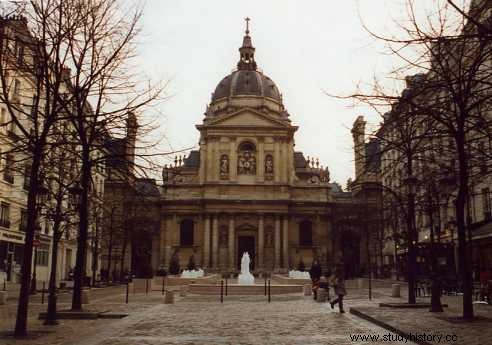The different art movements
Art in the High Middle Ages
Shortly after the fall of the Roman Empire, we witness the appearance of buildings with a centered plan based on the circle, the square or the octagon surrounded by semi-circles. Originally, with a thermal or leisure vocation for the Romans, but adopted as a religious building by the Christians. On the different sets, the characters are represented with very large eyes and fixed features, the individualization being done more by the clothes and the hair. The sarcophagi are carved in hard stones and carved with scenes of leisure and hunting. The barbarian invasions brought a new impetus to artistic culture (Childeric's tomb). Later, under Charlemagne, the cultural heritage of the Romans was brought up to date. In the field of manuscripts, the tiny caroline makes its appearance. A new part is made for finishes and details, as evidenced by the architecture and the sculpture. Ottonian art (Otton I) is an extension of the Carolingian Renaissance but with a Byzantine influence whose works of art circulate through the commercial channels. A lot of raw or polished stones are used (sapphires, rubies, emeralds). The Holy Roman Empire, where Emperor Otto reigns, succeeds the Carolingian Empire. Saxony is now the most flourishing region at the expense of France.
The Magi
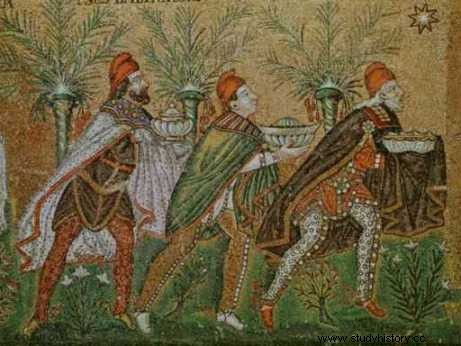
The Magi - by Saint Apollinare of Ravenna
Romanesque Art
Romanesque art was born from physical questions in the architectural field which appeared in the 10th century:replacing wooden ceilings with stones, widening the naves, increasing the height of churches and allowing light to penetrate better. The term Romanesque designates in part the affiliation with Roman art as well as the rise of Romance languages. The different characteristics are the search for capitals and vaults, the appearance of champlevé copper, the cult for relics, and the vogue for pilgrimages. From 1120, the carving of church eardrums began (space on the portals of churches decorated with sculptures), magnificent friezes made their appearance. In architecture, the vaults are wider, and in Normandy, under the reciprocal influence with England, we are already beginning to see the premises of Gothic. The Bayeux tapestry is the most representative work of this period. After the dislocation of the Carolingian empire, an interesting and original artistic form appeared in the Meuse, which would have some links with Ottonian art in Germany, and which would participate in the blossoming of Gothic art. It is Mosan art (from the Meuse) which is a "pivotal" art between Romanesque and Gothic.
The Bayeux Tapestry
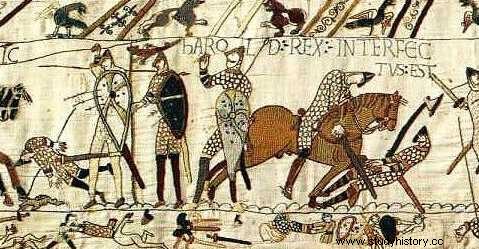
Episode from the Bayeux Tapestry
Gothic Art
Under the strengthening of the Capetian kings (Louis VII, Philippe Auguste...), this new art appeared in Île-de-France. The Gothic architect seeks to unite the masses, to melt the volumes. The flying buttress plays a role just as important as the warhead. It creates a vertical dynamic, it also reduces the supporting role of the wall. The large arcades are part of a desire to amplify the voids to the detriment of the solids. From then on, a great wave of reconstruction swept across France, because of fires or other events, the churches readapted to this new genre which quickly imposed itself. The stained glass windows are much better used, sometimes to the point of excessiveness (Cathedral of Reims). Furthermore, the sculptors affirm their originality through a complex interplay of curves and counter-curves in the folds, through effects of shadow and light. In all fields of art, light plays a dynamic role. Sculpture becomes a servant of architecture, this agreement corresponds to a great stylistic upheaval. Painting plays a more preponderant role, and we see the appearance of magnificent murals. Works of art are multiplying, especially in Limoges. Gothic art stands out as the characteristic art of the medieval style. But as always, art serves above all religion, it is only much later, in Flemish and Italian paintings, that we begin to paint ordinary people, and everyday scenes.
See the interactive description of a cathedral
Classification of art movements
- High Middle Ages
- Art of the High Middle Ages
- Late Middle Ages
- Romanesque
- Gothic art
- Rebirth
- Pre-Renaissance (1300-1400)
- Early Renaissance (1400-1500)
- High Renaissance (1500-1530)
- Late Renaissance or Mannerism (1520-1580)
- 17th century
- Baroque/Classicism
- 18th century
- Rococo
- 19th century
- Neoclassicism
- Romanticism
- Realism
- Impressionism
Literature in the Middle Ages
Troubadours and jugglers
According to tradition, the founder of troubadour lyric poetry was William IX (1071-1127), Count of Poitiers, Duke of Aquitaine, a more powerful vassal than the King of France. His compositions were strong and refined. Moreover, the troubadours most often belonged to the dominant classes. The jugglers, on the other hand, came exclusively from the working classes. The two “trades” were distinct. The troubadours composed their own verses and set them to music. Accompanied by a string instrument, the juggler was only the interpreter of these songs. The real artisan of Provençal poetry in the Middle Ages was the troubadour. Some were not always noble, however when a poet reached the recognized condition of troubadour, he was considered more like a marquis than an innkeeper. The South of France was a region attentive more than anywhere else to this lyrical phenomenon.
Troubadours - 12th century
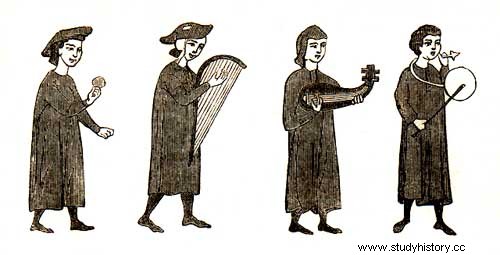
Praise of courtly love
The feudal structures were different in the North, where yes was called “oil” (language of oil). In the South, where the langue d'oc was spoken, women were an infinite source for Occitan poetry. In Languedoc, the woman had a wider political importance, she could lead the fief in the absence of her husband. Saint Bernard of Clairvaux, founder of the Cistercian Order had influenced the cult of the Virgin Mary. Thanks to Mary, woman had a representation of Creation, and therefore, a source of perfection. The Lady "sung" by a troubadour was not his wife, but that of a nobleman who was socially far above him. On a more secular level, Guillaume, abbot of Saint-Thierry, Saint-Bernard's friend, in his treatise "On the nature of love", places woman above man in the expression of this feeling. The feudal structure continuing to be the dominant rule of European society, the superiority achieved by the image of the woman compared to that of the lover, very platonic, ended up creating in this relationship a bond of vassalage similar to that of the knight with his lord. This is the courteous principle. Among these outward marks of "dependence" is that of submission reproduced in the miniatures where the Knight swears on his knees fidelity to his Lady. At that time, when marriages of interest were celebrated, it was tolerated for a troubadour to eulogize the wife of a noble. On the contrary, the wife found herself glorified, and consequently the husband too. However, physical love was secretly desired, but rarely consummated.
Medieval erotic scene
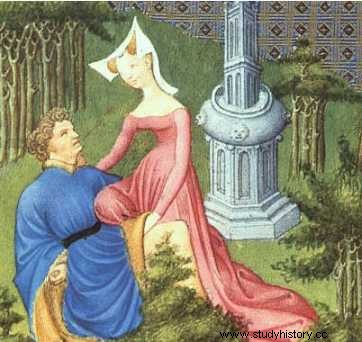
The song of gesture
The chanson de geste is the first form of secular literature written in the French language. It is the medieval form of the Latin epic, transposed to the world of war, of hagiographic poetry, of the exaltation of the lives of saints. The chanson de geste is a literary form of action as clearly indicated by the term gesture (from the Latin gesta:actions). The word song highlights the oral character of these texts which are, as a rule, sung and recited by the jugglers. A single day was not enough to recite the 4,000 verses of "La Chanson de Roland", the most famous of all. The manuscript sources are thus very different from each other given this oral character. These long narrative poems celebrated warlike prowess, heroes, usually French knights who had become legendary figures. The events narrated go back several centuries before the creation of the poem, but are revisited on the occasion of contemporary conflicts. The recurring theme of the crusade serves as a pretext to exalt warlike valor and the prowess of heroes against a mythical backdrop of superhuman battles and fabulous descriptions. Expressed in a Christian era, the chanson de geste conveyed a deep ideological charge, that of the struggle between Good and Evil. Christianity against the Muslim Saracens. Most of the songs are composed in the North-West of France (Normandy), but it is possible that the cradle of this poetic form was born in the South of France. The most famous songs are those of Roland, Charlemagne, William of Orange and El Cid.
Other literary forms
In the princely and seigniorial courts, hitherto very rough, the influence of the clerics and the contact with Eastern civilizations by means of the Crusades, gave birth to the taste for literature written in the language of the country. Besides the songs of gesture, seen previously, other literary forms were expressed. In the middle of the 12th century, Aquitaine poetry was introduced into the courts of the North:it sang in a precious language of the adventures and loves of knights. This genre reached its peak with the novels of Chrétien de Troyes:Perceval or Lancelot are monuments of French poetry. Then appeared the tales and chantefables, composed of pieces of prose and couplets in verse accompanied by melodies:Aucassin and Nicolette, in the 13th century already announced a more popular literature.
Perceval at the Grail Castle
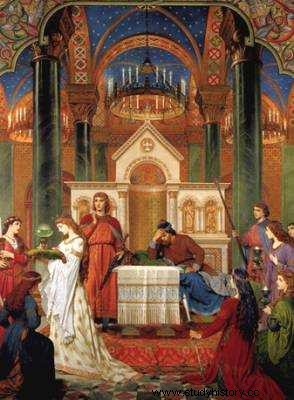
Percival visiting the castle of the Grail - by Ferdinand Piloty
Culture and education in the Middle Ages
Written or oral culture
The tales peddled by the minstrels were not the sole source of knowledge of the people. Passed down from father to son, the oral tradition inscribed facts, recipes and moral teachings in everyone's memory:proverbs, tales and legends, songs, recipes for curing such and such a disease formed popular culture to which was added the teaching of the Church. At that time, the printing press was not yet invented, books were written by hand by copyist monks who took a year or more to write or copy a single work. One wrote on sheets of parchment, obtained by tanning the skins of lamb and sheep. Books were so expensive that they were luxury items. There were very few books, but few people could read, let alone write. Each time one had to read a letter, to know the contents of a collection of laws, or to write a missive, one had recourse to a specialist. It was a job, and no one was surprised at the illiteracy of kings and princes.
The Church, driving force of culture
In the ocean of ignorance of the Middle Ages, the Church represented the unique “cultural institution” and the link between Antiquity and modern culture. In churches and convents, the conquests of the human race are carefully preserved:the Latin language, literature, sculpture, painting, the arts as well as the most precious techniques. Benedict of Nurcie, in the 6th century had recommended to the monks to learn the art of writing, to constitute a library in each convent and to constitute an elementary school open to all. It is thanks to this action that the great medieval culture was able to spread. But it was Charlemagne who ordered the opening of public schools in the monasteries. Schools multiplied near cathedrals, important churches and monasteries. The main role of these schools was to train future clerics. There were two schools near each cathedral:
- The "interior" school was reserved for those who wished to deepen their studies in order to enter the clergy.
- The “outside” school was a kind of elementary or primary school. The latter, which was also open to the poor, played a decisive role in the dissemination of knowledge in Europe.
A copyist monk
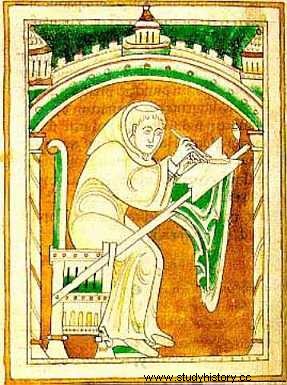
The first universities
After having acquired notions of arithmetic, grammar, geometry, music and theology, the student could continue his studies by going to a university. The university is a typically medieval creation, although different from ours today. Indeed, it was an association of students from very diverse regions and nations, who gathered around a master whom they paid for themselves. The doctors or professors often housed the students under their roof. Being a teacher in the Middle Ages was not easy, if he was not clear or boring, he was heckled and even roughed up. Clerics and students formed a separate category. United by the same love of knowledge, speaking Latin among themselves, great lovers of entertainment, they traveled in groups throughout Europe. These rowdy companies of itinerant students helped form an international culture.
The teaching of the Middle Ages
The major interest of the doctors focused on theology, that is to say the in-depth study of God and his work:Man and his destiny. The great center of theology was the Sorbonne, where Saint Thomas Aquinas reigned in the 13th century. Very quickly, philosophy or the study of ideas was added to theology. The rebirth of this discipline was largely due to the Arabs who had saved the works of Greek thinkers like Aristotle, which they had translated and commented on, before spreading them as far as the West. Alongside these two fundamental sciences, other disciplines related to practical necessities developed. Contact with the Arab world, and in particular with the school of Baghdad gave birth to great medical schools:Salerno in Italy, Seville in Spain, Montpellier in France became renowned centers for medical care and research. Towards the middle of the 14th century, after the epidemic of the Black Death which ravaged a third of the population, the spread of contagious diseases was discovered. Moreover, the development of commerce allowed mathematics to make considerable progress. Legal studies, on the other hand, received a great impetus thanks to the development of the state and centralized administration.
The Sorbonne
